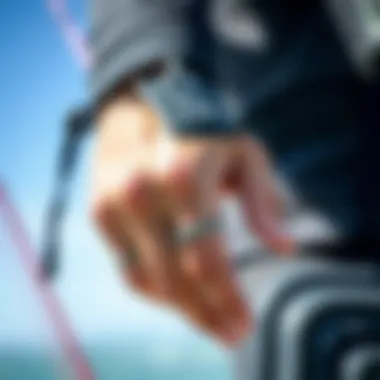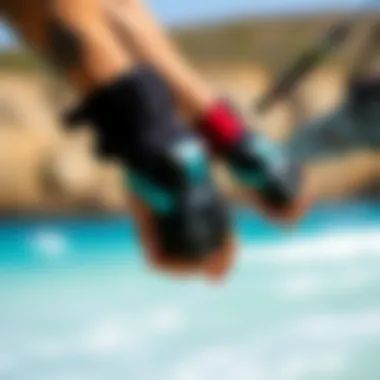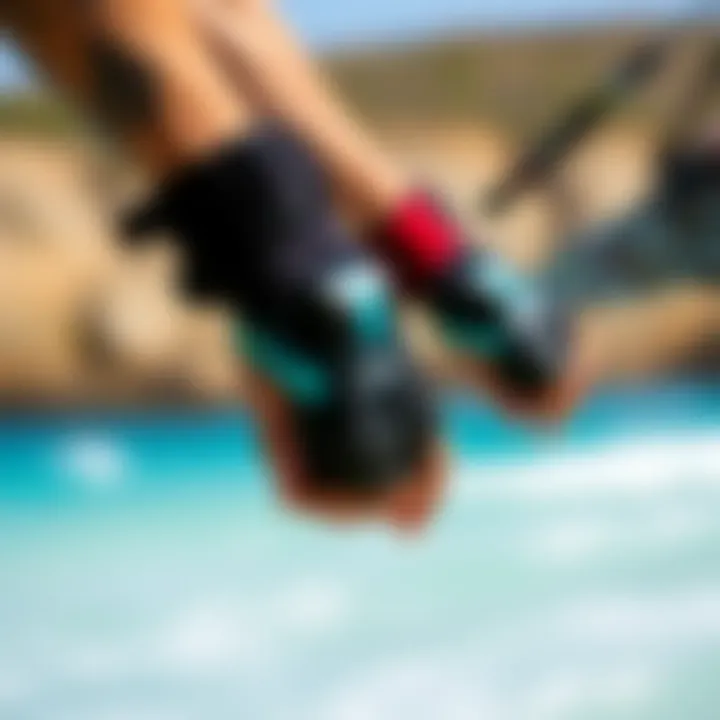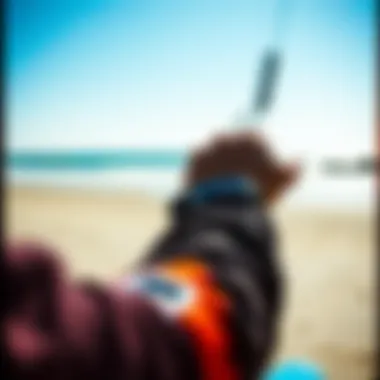Essential Insights on Wrist Harnesses for Kiteboarding


Intro
In kiteboarding, the equipment you choose can often make or break your experience on the water. Among various components, wrist harnesses stand out as a key element that enhances not only performance but also safety. Unlike their more common counterpart, the waist harness, the wrist harness is gaining traction due to its unique design and advantages. Designed with the specific dynamics of kiteboarding in mind, wrist harnesses allow for greater freedom of movement, which is essential for a sport that rewards flexibility and responsiveness.
Understanding the intricate workings of wrist harnesses can significantly impact how you control your kite and maneuver your board. This guide will provide a thorough exploration of wrist harnesses, including their design, functionality, and advantages. For kiteboarding enthusiasts, instructors, event organizers, and anyone invested in this thrilling sport, this resource aims to shed light on how wrist harnesses can elevate your kiteboarding experience.
Whether you’re looking to upgrade your gear or fine-tune your technique, insights found here will help you navigate the often-overlooked world of wrist harnesses. The importance of sustainability in gear production will also be addressed, ensuring your choices not only serve your personal goals but also align with broader environmental considerations.
Let's dive straight into gear selection, starting with the various types of kites and boards that better pair with wrist harnesses.
Prelims to Wrist Harnesses
In the world of kiteboarding, the right gear can make all the difference between a thrilling ride and a frustrating experience. Among the various components of kiteboarding equipment, wrist harnesses stand out as an essential tool not only for enhancing performance but also for ensuring safety. Understanding how wrist harnesses function and what distinguishes them is paramount for both novice and seasoned kiteboarders.
Understanding the Purpose
The primary role of a wrist harness is to connect the kiteboarder to the kite, providing a secure and comfortable way to manage the forces generated during riding. Unlike traditional harnesses that can pull on the body and create discomfort, wrist harnesses focus on distributing the pull evenly across the arm. This setup allows for greater freedom of movement, which many kiteboarders appreciate, especially when executing tricks or navigating choppy waters.
Wrist harnesses also serve as a safety device. They allow a kiteboarder to release their grip quickly in case of an emergency. This is crucial in situations where losing control could lead to injury or damage. Harnesses equipped with quick-release systems can enhance a rider's confidence, knowing they have an escape route if the situation takes a turn for the worse.
Moreover, the rise of kiteboarding as a sport has led to innovations in harness design, emphasizing not just functionality but also user comfort. The choice of materials and the fit of these harnesses can be critically important, especially on long rides.
In summary, wrist harnesses are not merely accessories but integral parts of kiteboarding gear that greatly influence control, safety, and overall performance. With the right wrist harness, kiteboarders can ride with greater assurance and expediency.
History of Harness Design
Looking back, the evolution of harness design reveals a fascinating journey that mirrors the development of kiteboarding itself. Early harnesses were quite minimalist, often resembling basic straps with limited adjustability. As the sport gained popularity in the late 1990s and early 2000s, manufacturers began experimenting with materials and designs that would better meet the needs of riders.
Over the years, the transition from the simple designs of yesteryear to today’s sophisticated harnesses has been significant. Notably, harnesses started incorporating adjustable straps and ergonomic designs, which led to improved fit and comfort. Riders began to favor harnesses that allowed a greater range of motion, responsive to the dynamic nature of kiteboarding.
An interesting stride in harness evolution came with the introduction of integrated systems that combine the harness with the safety leash and attachment – a step that made it easier for enthusiasts to manage their gear. Innovations around durability have also surfaced, with fabric technology improving resistance to water, UV rays, and wear and tear.
Today, shape, style, and functionality are paramount in harness design. From lightweight materials to the specific shape that complements the rider’s movements, the wrist harness has transformed significantly, echoing a journey of necessity and innovation. Riders now benefit from a plethora of options allowing for personal preference in style and performance, making it crucial for new kiteboarders to understand these differences.
"The right harness can make it feel like you're flying, almost like the kite is an extension of your body."
As we dive deeper into the various types of wrist harnesses, it's important to appreciate this transformative journey that has shaped what riders wear today.
Types of Wrist Harnesses
Understanding the various types of wrist harnesses is vital for any kiteboarder looking to optimize their experience on the water. Each design presents distinct features, catering to different skill levels and preferences. This section will explore how these harness types serve unique functions and underline their significance in both comfort and performance.
Traditional Wrist Harnesses
Traditional wrist harnesses, often seen as the backbone of kiteboarding equipment, remain a popular choice among enthusiasts and professionals alike. These harnesses typically feature a simplified design, comprising a sturdy strap that wraps around the wrist and adjusts for a customized fit. The main advantage of traditional harnesses lies in their straightforward functionality; they provide immediate attachment to the control bar, allowing kiteboarders to maneuver their kites without hindrance.
Benefits of Traditional Wrist Harnesses:
- Simplicity: Their easy-to-use design facilitates quick adjustments on the water.
- Lightweight: Many models are made from lightweight materials, reducing overall bulk, which is crucial for dynamic movements.
- Direct Connection: They offer a very direct connection between the rider and the kite, aiding in responsiveness and control.
However, these harnesses may lack additional features seen in more modern designs. Riders who require extra security or comfort upgrades might find themselves looking elsewhere after experiencing fatigue from extended use.
Integrated Harness Systems
On the other end of the spectrum, integrated harness systems incorporate multiple elements into a single unit. These can include built-in impact vests or flotation devices that combine safety features directly with the harness itself. The functionality of integrated systems is designed for comprehensive support, elevating the protective aspects considerably.


Advantages of these systems often include:
- Enhanced Safety: With protective vests sewn in, these harnesses can mitigate injury risks, especially in turbulent water conditions.
- Streamlined Gear: The all-in-one approach lessens the need for multiple pieces of equipment, helping kiteboarders travel lighter.
- Versatility: Such systems can cater to various conditions and riding styles, making them an excellent choice for those who frequently kite in diverse environments.
While integrated systems generally provide more extensive protection, they can also be bulkier compared to traditional options, which may not be favorable for every rider.
Adjustable Features
Another aspect worth noting is the adjustable features of wrist harnesses, which impact the overall fit and user experience. Some harnesses now highlight modular designs, allowing users to fine-tune settings according to their body shape and activity level. Common adjustable elements include:
- Strap Length: Many harnesses come equipped with extendable and retractable straps, making it easier to achieve a snug and comfortable fit.
- Quick-Release Mechanisms: These enable users to detach easily from the kite in emergencies, a critical feature in preventing accidents on the water.
- Padding Adjustments: Certain models offer removable padding, allowing for personalized comfort based on individual preferences.
Having the ability to adjust your harness for both fit and function means that you can focus more on your skill development rather than discomfort in your gear.
Benefits of Using a Wrist Harness
Wrist harnesses are not just mere accessories in kiteboarding; their significance is paramount for both performance and safety. When kiteboarders strap on a wrist harness, they are engaging in a subtle dance—where every tug of the kite translates into an enhanced experience on the water. Grappling with the elements becomes more artful, allowing for sharper turns and smoother aerial maneuvers. However, the benefits extend beyond just improved handling; understanding this equipment can dramatically elevate a kiteboarder’s proficiency. Here, we will dive into three primary benefits of using a wrist harness: improved control and handling, enhanced safety measures, and the convenience it offers in managing gear.
Improved Control and Handling
A wrist harness is a game changer when it comes to the steering of your kite. By allowing the kiteboarder to anchor their kite with precision, the harness ensures every movement is more deliberate and controlled. Instead of wrestling with the kite using just one’s arms, the harness lets practitioners engage their core and weight securely, leading to a far more effective transmission of energy.
- With a wrist harness, you can:
- Apply more significant force with less physical strain.
- Enjoy a better distribution of load, making your rides smoother.
- Have an increased connection to the kite, leading to enhanced responsiveness.
This level of control can mean the difference between a thrilling jump and a tumble into the water. Ultimately, for those looking to refine their technique, investing in a quality wrist harness is essential for mastering advanced tricks.
Enhanced Safety Measures
Safety in kiteboarding cannot be underestimated, and here is where the wrist harness shines brightly. The harness binds the kiteboarder to the kite in a way that can mitigate common injuries. For instance, should one fall or lose control, the proper use of a harness reduces the chance of being dragged along the water or being pulled into the air, guarding against potential accidents.
Moreover, many wrist harnesses are engineered with quick-release mechanisms. This feature allows a kiteboarder to disengage swiftly in emergencies, providing an added layer of security.
"A good wrist harness is like a well-fitted helmet; you hope you never need it, but you’ll be grateful that you used it."
Convenience in Gear Management
The convenience offered by a wrist harness can’t be praised enough. The struggles of managing lines and kites while trying to maintain a grip can be overwhelming. However, a wrist harness leaves your hands relatively free and more flexible.
- Here’s how it can simplify your kiteboarding experience:
- Quick Adjustments: No need to fumble with cumbersome straps when you need to make quick adjustments mid-ride.
- Easier Transitions: Transitioning from land to water becomes much more seamless. The harness allows you to maintain control and flow, minimizing interruptions.
- Reduced Wear and Tear on Arms: Because you are utilizing a harness, there’s less strain on your forearms and wrists. This not only enhances endurance but also decreases the chances of developing fatigue during long sessions on the water.
Selecting the Right Wrist Harness
Choosing the right wrist harness is more than just a matter of aesthetics or brand preference; it plays a pivotal role in enhancing your overall kiteboarding experience. The right harness can mean the difference between smooth sailing and an annoying day spent wrestling with your gear. When selecting a harness, several factors come into play. Understanding your personal needs, the durability of materials, as well as comfort considerations are paramount to making the best choice.
Assessing Personal Needs
Before you even glance at harness options, take a step back to assess your individual requirements. Are you a beginner just starting out, or a seasoned kiteboarder who frequently rides in variable conditions? This can greatly influence the type of harness that suits your needs. For instance, a novice might prioritize ease of use and safety features, opting for a more forgiving design. Conversely, a pro might look for something that offers maximum performance and adjustability.
Additionally, consider your riding style. Freestyle enthusiasts may need a harness that offers more mobility, while those focused on wave riding will want something secure that stays put. Knowing exactly what you require from your harness ensures that you don’t end up purchasing something that only meets half of your needs. It's essential to identify these needs in advance for a seamless riding experience.
Evaluating Material Durability


The durability of materials used in wrist harnesses cannot be overlooked. Kiteboarding gear takes a beating from the elements; thus, your harness needs to withstand heavy use and adverse conditions. When evaluating materials, make sure to look for high-quality fabrics, reinforced stitching, and durable hardware. Popular options include ripstop nylon and polyester, often treated for UV resistance and water repellence.
An effective way to gauge durability is to check reviews from real users. Insights from experienced kiteboarders will give you a clearer picture of material performance in the field. Thoroughly examining a harness’s material can save you from mid-session failures and ensure longevity.
Fit and Comfort Considerations
The fit and comfort of a wrist harness are not just about how it looks, but how it feels during your ride. An ill-fitting harness can lead to discomfort, limiting your ability to perform at your best. Pay attention to the adjustability features—many harnesses come with adjustable straps that cater to individual body shapes and sizes. Ensure that it fits snugly but allows for movement without chafing or pinching.
A way to find the ideal fit is to try out various harnesses in shops or at kiteboarding events. Some brands even allow you to test them in the water. A comfortable fit should feel like a second skin, providing support without restricting you. Never underestimate the importance of this consideration; comfort can keep you riding longer and with greater enjoyment.
"A good harness should feel just right, not tight."
Taking time to ensure you are making an informed choice will lead to better sessions on the water.
In summary, selecting the right wrist harness involves understanding your personal needs, evaluating material durability, and finding the perfect fit. This thorough examination can vastly improve your kiteboarding experience, paving the way for more enjoyable and successful rides.
Usage Guidelines for Wrist Harnesses
Understanding how to effectively use wrist harnesses is crucial for both novice and seasoned kiteboarders alike. The way a harness is worn and maintained can significantly enhance comfort, control, and, most importantly, safety on the water. With kiteboarding being a sport that demands physicality and precision, adhering to proper guidelines will help you avoid unnecessary mishaps and maximize your performance.
Proper Wearing Techniques
Wearing a wrist harness might seem straightforward, yet it requires attention to detailed techniques to ensure it functions as intended. First off, the harness should sit snugly on your wrist without being overly tight. You want it to feel secure but not constricting. Positioning is key; the strap should be aligned with the proper part of your wrist for optimal leverage against the kite’s pull. Here’s a step-by-step outline to keep in mind:
- Ensure the harness is the right size for your wrist. Too large and it won't provide the needed support; too small and it can cut off circulation.
- Put the harness on before your session, adjusting the straps to find that sweet spot where it feels like a second skin.
- When fastening, check for mobility. You should be able to rotate your wrist comfortably while keeping the harness snug.
- Always double-check that the safety release mechanism is easily accessible and functional, as this ensures quick release in emergencies.
"Wrist harnesses may seem simple, yet their proper usage can make or break your ride. Don’t underestimate their importance!"
Maintenance Tips
Keeping your wrist harness in good condition is not only sensible but also vital for your safety on the water. After each session, it's recommended to rinse the harness with fresh water to remove any salt or sand that might have accumulated. These tiny particles can wear down the material over time. Here are a few straightforward maintenance tips:
- Inspect the straps and buckles regularly. Look for signs of wear or fraying. A damaged strap can easily lead to accidents.
- Store it in a cool, dry place. Avoid leaving it out in direct sunlight for long periods, as UV rays can degrade the materials.
- Use a mild detergent for cleaning if you notice any stubborn stains. Avoid bleach or harsh chemicals as they can break down the fabric fibers.
Common Mistakes to Avoid
Even experienced kiteboarders can overlook essential aspects of using wrist harnesses, leading to dire consequences. Here’s a rundown of common pitfalls:
- Ignoring the fit. A poorly fitting harness can cause chafing or detachment during a ride. Always try before you buy and make adjustments as necessary.
- Neglecting the quick-release mechanism. Always verify that it works properly before heading out. This ensures you’ll have an escape route if things go awry.
- Skimping on maintenance. Post-session care may seem tedious, but it prolongs the harness's life and keeps you safe.
Being mindful of these guidelines will empower kiteboarders to use wrist harnesses not just as an accessory, but as an essential part of their kiteboarding arsenal. By following proper wearing techniques, maintaining equipment, and avoiding common mistakes, you can enhance your overall experience on the water.
Wrist Harnesses in Various Conditions
Wrist harnesses play a key role in kiteboarding, especially when it comes to navigating the unpredictable nature of wind and water. The effectiveness of a wrist harness can drastically change depending on the conditions one finds themselves in. Understanding how different environments affect the performance of these harnesses can enhance a rider's overall experience and safety.
Performance in Strong Winds
Riding in strong winds can be exhilarating, but it also poses considerable challenges. In these conditions, a well-functioning wrist harness is imperative. Riders often find themselves managing high tension and exerting significant force against the kite pull. Using a reliable wrist harness allows for better grip and control, reducing the chance of injury.
It’s essential to select a harness that features reinforced stitching and robust materials, designed specifically to endure high-stress situations. Some popular choices among experienced kiteboarders include models like the Mystic Majestic or the Duotone Rush. These harnesses are built to ensure that the rider can maintain connection with the kite while comfortably absorbing powerful wind gusts.
"In strong winds, maintaining stability is key. A good harness can make all the difference in handling the kite effectively and safely."
Adapting to Changing Weather


Weather can be as fickle as a cat on a hot tin roof, and kiteboarders often face rapidly shifting conditions. One moment it’s a light breeze, and the next, gusts are howling across the water. Therefore, having a wrist harness that is adjustable and flexible is crucial. Riders should look for harnesses that allow for quick adjustment without much fuss.
When conditions change, your harness needs to stay snug but comfortable. Harnesses such as the Naish Torque are designed with quick-release features, allowing changes on the fly. Another aspect to keep in mind is the weight of the harness. Lighter materials often provide better maneuverability during dynamic weather changes, allowing kiteboarders to adapt seamlessly.
Water and Land Use Cases
The versatility of wrist harnesses is not limited to just water conditions; land usage can also greatly affect the choice you make. For example, those who engage in kite landboarding need harnesses that can handle the stress during land runs and sudden stops. In contrast, harnesses used for traditional kiteboarding can sometimes afford to be more streamlined.
While surfing waves may also impact how a rider uses their harness, it's significant to note that safety precautions still apply.
- Water Use Cases:
- Land Use Cases:
- Frequent immersion means choosing harnesses resistant to salt and fresh water.
- Many riders prefer thicker straps for added support while maneuvering through waves.
- Harnesses with extra padding can help cushion the impact against hard surfaces.
- Adjustable fittings can provide comfort when riding on varying terrains.
In summary, understanding how wrist harnesses function in different conditions is essential for kiteboarders. Each scenario—from fierce winds to shifting climates and from water to land—has its own set of challenges and demands. Choosing the right wrist harness based on these factors can optimize performance, enhance safety, and make the entire kiteboarding experience far more enjoyable.
Environmental Considerations
In the realm of kiteboarding, where adventure meets nature, the impact of our choices on the environment has gained paramount importance. The materials used in wrist harnesses and the ethics behind their production are not just footnotes in the conversation; they’re the backbone of sustainable practices. Kiteboarders, instructors, and enthusiasts alike should be aware that our sport can harmoniously coexist with nature if we make thoughtful decisions about the equipment we choose and how it’s produced.
Sustainable Material Choices
When selecting a wrist harness, the materials employed play a crucial role beyond just performance. Many manufacturers are now leaning toward environmentally friendly materials, seeking to reduce the ecological footprint while enhancing functionality. For instance, harnesses made from recycled plastics or organic fabrics offer durability alongside a commitment to sustainability.
- Recycled Nylon: Traditional nylon contributes to a hefty environmental impact due to its production process. In contrast, using recycled nylon mitigates this issue, repurposing waste into high-quality gear.
- Organic Cotton: This material is a popular choice for comfort and breathability. It’s cultivated without harmful pesticides, thus lessening the environmental strain.
- Bio-based Foams: Manufacturers are increasingly utilizing foams derived from renewable resources in place of petroleum-based products, aiming to offer a more sustainable solution that doesn't compromise on comfort.
A quick note: choosing gear made from sustainable materials might not only lessen your carbon footprint but also offer additional benefits, such as improved breathability and comfort during long sessions on the water. As kiteboarders, we can drive change by supporting brands that prioritize sustainability in their products.
Manufacturing Ethics
The conversation around environmental sustainability doesn’t stop at materials; it extends to manufacturing ethics. The conditions under which our gear is produced significantly influence the overall sustainability of the sport. Many brands are now scrutinizing their supply chains to ensure fair labor practices, safe working conditions, and minimal environmental harm.
Here are some ethical practices to look for in wrist harness manufacturing:
- Fair Labor Practices: Companies committed to ethical manufacturing ensure they provide fair wages and safe working environments for their workers.
- Local Sourcing: Brands that source materials locally not only decrease transportation emissions but also support local economies.
- Transparency: Look for companies that are open about their manufacturing processes. Transparency is a key indicator of ethical practice.
- Waste Reduction: Innovative manufacturing techniques that focus on minimizing waste are becoming more mainstream. This includes strategies like zero-waste design and responsible disposal practices.
"The choices we make as consumers can drive significant change in the industry. Supporting ethical brands is a step towards protecting our playgrounds in the ocean and the shores we love."
For more insights into sustainable practices in sports gear and apparel, you can refer to Sustainable Apparel Coalition or explore ongoing discussions on platforms like reddit.com.
By striving for sustainability, we can make a tangible difference, steering our sport towards a brighter and greener future.
Finale
The discourse surrounding wrist harnesses in kiteboarding is not merely an exercise in understanding gear; it's a lens into how equipment can remarkably enhance or impede performance on the water. As kiteboarding continues to grow in popularity, the significance of selecting the right wrist harness becomes increasingly clear. The appropriate harness isn't just an accessory; it’s a pivotal component that directly impacts the rider’s experience, control, and safety during their time on the water.
Recap of Key Points
As we wind down this guide, it’s important to pull together the threads discussed throughout:
- Wrist Harness Types: From traditional designs to integrated systems, each type serves unique needs, making it essential for riders to choose based on their style and conditions.
- Benefits: Improved handling, enhanced safety features, and convenience in managing gear underscore the importance of wrist harnesses.
- Selection Criteria: Assessment of personal needs, material durability, and comfort should guide every choice, making sure the harness is molded well to the user's body and riding style.
- Usage and Maintenance: Proper techniques while wearing and caring for the harness can prolong its life and effectiveness, while avoiding common errors ensures optimal performance.
- Environmental Impact: Sustainable materials and ethical production practices matter. They contribute not only to cleaner waterways but also to a positive community perception of the sport.
Looking Ahead in Gear Innovation
The future of kiteboarding gear, especially wrist harnesses, is on an upward trajectory, echoing technological evolution in the broader sports equipment arena. The push for lightweight, durable materials promises harnesses that can withstand the elements without weighing down the rider. Alongside this, innovations such as modular designs allowing for customizable features could transform how athletes interact with their gear.
Riders could soon see developments focused on integrated smart technologies, such as GPS tracking or performance analytics embedded in the harness design. This move toward smarter gear supports athletes in pushing their limits while remaining safe. As the kiteboarding community becomes more vocal about sustainability, manufacturers are likely to prioritize eco-friendly materials and processes, ensuring the sport remains viable for future generations.
In closing, those involved in kiteboarding—be they amateur riders or seasoned professionals—should keep a keen eye on these developments. The evolution in wrist harness technology will not only enhance performance but also cultivate a deeper connection to the elements, enriching the overall kiteboarding experience.
"The choice of your harness can either be your anchor or your wings in the sky of kiteboarding." - A reminder of the importance of informed decisions in gear selection.















